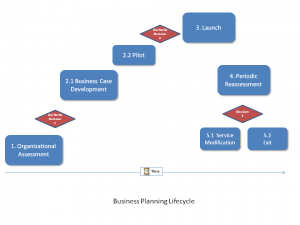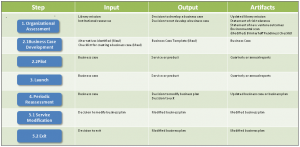Recommendations: Part IV, The Business Planning Life Cycle
¶ 1 Leave a comment on paragraph 1 0 The above recommendations concerning the assessment of organizational readiness and business case development can be seen in the context of a larger business planning life cycle, as visualized in figure 1 (Traditional product management methodology uses variations on product life-cycle management that typically begin with ideation in the innovation context and continue through several stages to product modification or exit.)
¶ 2
Leave a comment on paragraph 2 0
 Figure 1 The Business Planning Life Cycle
Figure 1 The Business Planning Life Cycle
¶ 3 Leave a comment on paragraph 3 0 Details of the life cycle are described in table 1.
¶ 4
Leave a comment on paragraph 4 0
 Table 1: The Business Planning Lifecycle
Table 1: The Business Planning Lifecycle
¶ 5 Leave a comment on paragraph 5 0
¶ 6 Leave a comment on paragraph 6 0 Elements of the Business Planning Life Cycle
¶ 7 Leave a comment on paragraph 7 0 Organizational assessment
¶ 8 Leave a comment on paragraph 8 0 Part I of the Recommendations above provides a four-step process for managing an organizational assessment. At the end of that process, the team proposing the new venture should conduct a go/no-go decision analysis to determine the likelihood of success in moving to the next step of the planning life cycle. The team should analyze the output of all four steps:
¶ 9 Leave a comment on paragraph 9 0 1. Mission review. Is the new venture consistent with the library’s mission statement? If the mission statement was successfully revised as a result of the review, then there is good reason to proceed to business case development. If the mission statement was not compatible with the new venture or there was not sufficient agreement with stakeholders on the revisions, then there is risk in moving forward to the next step. If the latter is true, but the new venture team has high confidence in the value proposition of the emerging proposal, then the team should consider affiliating with an allied institution or pursuing independent sponsorship and funding of the venture.
¶ 10 Leave a comment on paragraph 10 0 2. Risk tolerance. Use the results of this step to gauge the risk tolerance of the parent institution. Decide if the institution will tolerate the risk in a way that will allow the venture to flourish. If not, then consider a no-go decision or alternative affiliation.
¶ 11 Leave a comment on paragraph 11 0 3. Mission outcomes. How compelling are the newly articulated outcomes? Are they clearly stated and likely to inspire the team and consumers of the service? Answers to these questions will inform a go/no-go decision.
¶ 12 Leave a comment on paragraph 12 0 4. Resources. Use the modified Brinckerhoff readiness checklist to analyze resource readiness.
¶ 13 Leave a comment on paragraph 13 0 The new venture team should also consider a comprehensive review of the overall balance between opportunity, resources, and the strength of the team in assessing the likelihood of success (Timmons and Spinelli 2009). Timmons and Spinelli argue that success in the entrepreneurial process can be predicted by the balance of opportunity, resources, and team. If any of those elements are out of balance, then the likelihood of success is reduced. They describe the entrepreneurial process as follows:
- ¶ 14 Leave a comment on paragraph 14 0
- It is opportunity driven
- It is driven by a lead entrepreneur and an entrepreneurial team
- It is resource parsimonious and creative
- It depends on the fit and balance among these
- It is integrated and holistic
- It is sustainable
¶ 15 Leave a comment on paragraph 15 0 The Timmons model of the entrepreneurial process encourages a holistic view of three core components:
¶ 16 Leave a comment on paragraph 16 0 Opportunity. The Timmons model reminds us that “a good idea is not necessarily a good opportunity” (Timmons and Spinelli 2009, 111). The model encourages an analysis of market demand, a thorough understanding of market structure and size, and margin analysis as a way to differentiate an opportunity from an idea.
¶ 17 Leave a comment on paragraph 17 0 Resources. Librarians will be well acquainted with a principle that is difficult for for-profit entrepreneurs to understand: it is not necessary “to have all the resources in place, especially the money, to succeed with a venture” (Timmons and Spinelli 2009, 112). However, the team should be prepared to spend considerable time in the business case step on the analysis of required financial and tangible resources to make the case for a successful venture. Brinckerhoff provides definitions and worksheets for financial analysis, including forms for start-up cost estimation, a helpful form for calculating working capital needs for the first year, and a model for income and expense statements (Brinckerhoff 2000). In analyzing the need for financial resources, the first worksheets are an excellent resource for determining resource needs for start up and the first year of launch—a comparison of those needs with the available financial resources tells the team whether or not resources are in balance with the other components of the Timmons model.
¶ 18 Leave a comment on paragraph 18 0 Team. The analysis of the quality of the team is the least quantitative of the components. The authors argue that the successful venture requires “an entrepreneurial leader” and that the quality of the team should be evaluated by reviewing characteristics such as
- ¶ 19 Leave a comment on paragraph 19 0
- Relevant experience and track record
- Motivation to excel
- Commitment, determination and persistence
- Tolerance of risk, ambiguity, and uncertainty
- Creativity (Timmons and Spinelli 2009, 113)
¶ 20 Leave a comment on paragraph 20 0 The outcome of the organizational assessment process is to make a go/no-go decision on proceeding to the business case step.
¶ 21 Leave a comment on paragraph 21 0 Business case development
¶ 22 Leave a comment on paragraph 22 0 The development of the business case is described above in Part II of the Recommendations. After preparing a full description of the expected outcome and options for implementation, analyzing risk, and developing an implementation plan, the team can proceed to selecting the most appropriate option(s) for piloting. Upon the conclusion of the pilot, the business case itself should be updated to reflect lessons learned and new data gathered. At this point, a go/no-go decision on the entire venture is appropriate.
¶ 23 Leave a comment on paragraph 23 0 Launch
¶ 24 Leave a comment on paragraph 24 0 Product launch is beyond the scope of this study, but there exists a significant literature in the areas of product marketing and the execution of business planning.
¶ 25 Leave a comment on paragraph 25 0 Periodic reassessment
¶ 26 Leave a comment on paragraph 26 0 The subsection above on organizational assessment provides a model for initial assessment and periodic reassessment. The four steps of assessment described there can be utilized to verify that there has not been a change in overall institutional support for the venture.

Comments
0 Comments on the whole Page
Leave a comment on the whole Page
0 Comments on paragraph 1
Leave a comment on paragraph 1
0 Comments on paragraph 2
Leave a comment on paragraph 2
0 Comments on paragraph 3
Leave a comment on paragraph 3
0 Comments on paragraph 4
Leave a comment on paragraph 4
0 Comments on paragraph 5
Leave a comment on paragraph 5
0 Comments on paragraph 6
Leave a comment on paragraph 6
0 Comments on paragraph 7
Leave a comment on paragraph 7
0 Comments on paragraph 8
Leave a comment on paragraph 8
0 Comments on paragraph 9
Leave a comment on paragraph 9
0 Comments on paragraph 10
Leave a comment on paragraph 10
0 Comments on paragraph 11
Leave a comment on paragraph 11
0 Comments on paragraph 12
Leave a comment on paragraph 12
0 Comments on paragraph 13
Leave a comment on paragraph 13
0 Comments on paragraph 14
Leave a comment on paragraph 14
0 Comments on paragraph 15
Leave a comment on paragraph 15
0 Comments on paragraph 16
Leave a comment on paragraph 16
0 Comments on paragraph 17
Leave a comment on paragraph 17
0 Comments on paragraph 18
Leave a comment on paragraph 18
0 Comments on paragraph 19
Leave a comment on paragraph 19
0 Comments on paragraph 20
Leave a comment on paragraph 20
0 Comments on paragraph 21
Leave a comment on paragraph 21
0 Comments on paragraph 22
Leave a comment on paragraph 22
0 Comments on paragraph 23
Leave a comment on paragraph 23
0 Comments on paragraph 24
Leave a comment on paragraph 24
0 Comments on paragraph 25
Leave a comment on paragraph 25
0 Comments on paragraph 26
Leave a comment on paragraph 26